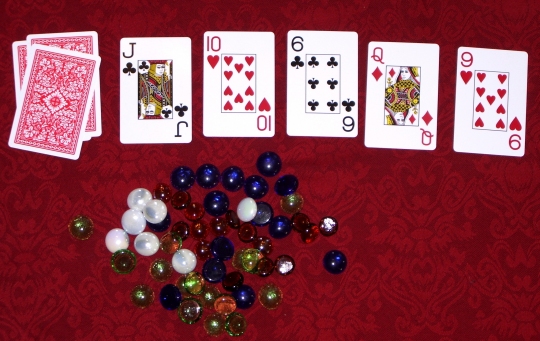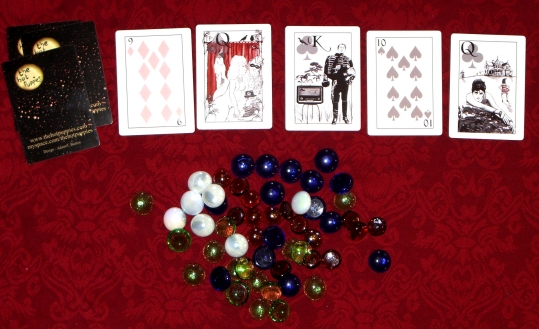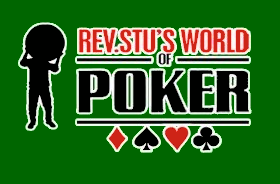|
HOUSE RULES
with The Reverend Stuart Campbell
If
you’ve ever watched a Tournament Director setting out the tables and
chips, shouting out the blind levels when the timer beeps and
tidying everything away at the end of the game, or if you’ve already
had a few informal games with mates, you might have formed the
conclusion that running a proper poker game is incredibly easy.
Well,
you’re wrong. Actually, it’s only pretty easy, and over the
next six months we’re going to take a journey through the running of
successful tourneys and cash games, from the simplest no-budget
kitchen-table affair right up to the point where you’ll be able to
handle the management and administration of an entire league. We’ll
also be learning what the best kit is to give you the ultimate poker
experience without breaking the bank, and what some of the pitfalls
are that lead to a friendly evening of card-playing ending up with
squadrons of police cars at your front door and a hefty glazier’s
bill.
So
this month, the basics. All you absolutely NEED for a game of poker
is a deck of cards and something to bet with, but you don’t really
want to all be sat on the carpet and straining your spines shunting
piles of Chewits wrappers around, so first set yourself up with a
nice sturdy table and some friends.
A lot
of home games fail even at this early stage, because poker is best
with 7-10 players to a table and most people’s dining rooms only
come with four or maybe six chairs, so it can be surprisingly hard
just to get everyone sensibly seated (ie without some poor sap
perched on a little footstool or a living-room armchair two feet
lower than everyone else with the cards flying straight into their
eyes). That’s a pretty embarrassing way to screw up your first
game-hosting evening, so make sure you’ve got somewhere for everyone
to sit, even if it means asking some people to bring their own
chair.

Even an ordinary tablecloth or
sofa throw, firmly secured, can still give you
a fairly classy playing surface, and the glass stones will look good
on it.
If
you’ve chosen a ring game (see CASH OR TOURNAMENT? below) you can
play with actual money instead of chips, but it’s a bit tacky and it
needs someone to go to the bank in advance for a hefty bag of
change. (Unless you’re one of those people who keeps a big jar of
shrapnel to save up for stuff the missus won’t let you buy normally,
in which case you have bigger problems than inexpertly-run poker
games.) And if you use Smarties, it’s hard to avoid eating your
stack.
If
you don’t want to fork out for a set of proper chips at this point,
an excellent cheap alternative are the little coloured-glass
“stones” that you can find in pet shops, craft stores and
supermarkets for putting in fishtanks and the like. A fiver will
sort you out with enough of those for a dozen or more players, and
they’re nicely weighted with a solid clinking sound that isn’t too
girly, and makes you feel as if you’re playing with a bunch of
hard-bitten South African diamond miners.
And
bear in mind that if you’ve gone for a tournament game you should
always remember to provide some entertainment for bustouts. Obvious
examples are a games console or some DVDs to watch, but those are
noisy and can end up being distracting for the players still left in
the game, so a bunch of quality magazines – such as this one you’re
reading now – is probably the best idea for occupying bustees
quietly. Another option is to keep them involved by getting them to
act as dealer, but obviously that only works for the first person
out.

Of course, you can always make
a virtue out of necessity, and use your lack of Vegas-style
casino gear to turn your card game into an Edwardian-dandy theme
night.
So
that’s the Home Poker For Dummies stuff sorted. These simple steps
should give you a workable game with no major disasters, and next
month we’ll start getting into an altogether more professional sort
of setup. There might be some nudity. See you then!
|
THINNING THE FIELD
Once you've
sorted out the basic mechanics, you're going to want to have a
think about what sort of game it is that you actually want to
host. There are roughly four million variants of poker, so
which format is best suited to your players?
|
|
CASH OR TOURNAMENT?
The very first decision you’re going to
have to make is whether you're going to go for a tournament or
a ring game (more commonly called a “cash game”, even though
both types are obviously played for cash). The main advantage
of a tournament is that it limits the maximum amount anyone
can lose, and is therefore good for protecting friendships,
while the main point in favour of a ring game is that you
don’t have a situation where someone busts out in the first
five minutes and has to spend the rest of the night twiddling
their thumbs and/or getting bored, drunk and disruptive.
A compromise we’ve recently trialled
successfully in our own poker group is a £20 freezeout tourney
with a single rebuy or top-up of £10 for half the original
starting stack if you bust out or fall below a certain level
(say half or a quarter of what you started with) at any time
in the first 90 minutes. That puts a pretty modest ceiling on
anyone’s losses, but gives everyone a second chance in the
event of getting over-excited early on and donking off all or
most of their chips. Making the rebuy only half of the
starting stack encourages more careful play in future.
|
|
LIMIT OR NO LIMIT?
If this is your first stab at a home game,
or if some of your players are new to poker, no-limit hold’em
is probably jumping in at the deep end. Remember, everyone was
a noob once, and if you get constantly bullied with scary
all-ins you’re probably going to have no fun and not want to
come back. (And you want that inexperienced dead money at your
table every week, don’t you…?)
On the other hand, limit poker is horribly
dull, almost impossible to win at if you get rotten cards, and
is actually the most complicated form of the game, none of
which are attractive traits for the beginner. So consider
playing pot-limit for at least your first few games, whether
ring or tourney – it helps novices restrict their losses in
any given hand, while the more veteran players at the table
can easily effectively turn the game into no-limit anyway when
they tangle with each other.
|
|
BUILDING A STRUCTURE
Structure isn’t quite as important in home
games as it is at “outside” locations, because obviously you
don’t have a rigid closing time you have to be finished by.
But you don’t really want to be going on until 7 o’clock in
the morning, so if you’re playing a tournament you should
structure the blind levels so as to be done at a reasonable
hour.
(In a ring game, you can just set a finish
time and then cash everyone out when you reach it. But stick
to it, and don’t let anyone have “just another couple of
hands” to try to recoup their losses, because that can end
very badly.)
As a very rough rule of thumb, you can
expect a game to be over when the big blind is about one level
below the starting stack – that is, if you start with 8000
chips, you’ll probably get a winner around the time the blinds
get to 3000/6000. So build your structure with that aim in
mind, and keep the progression of levels reasonably steady so
there’s a good balance between stagnation and a crapshoot.
Levels 25 minutes long, give or take 5 minutes, are a good
ballpark.
|
The Reverend is Assistant Organiser of the
Bristol & South West
Poker Meetup Group, which runs scheduled single- and multi-table
tournaments and cash games at numerous venues across the region and
is sponsored by Poker.co.uk.

(Click the banner to play with other RSWoP viewers, and earn
RSWoP referral bonuses.)
|

